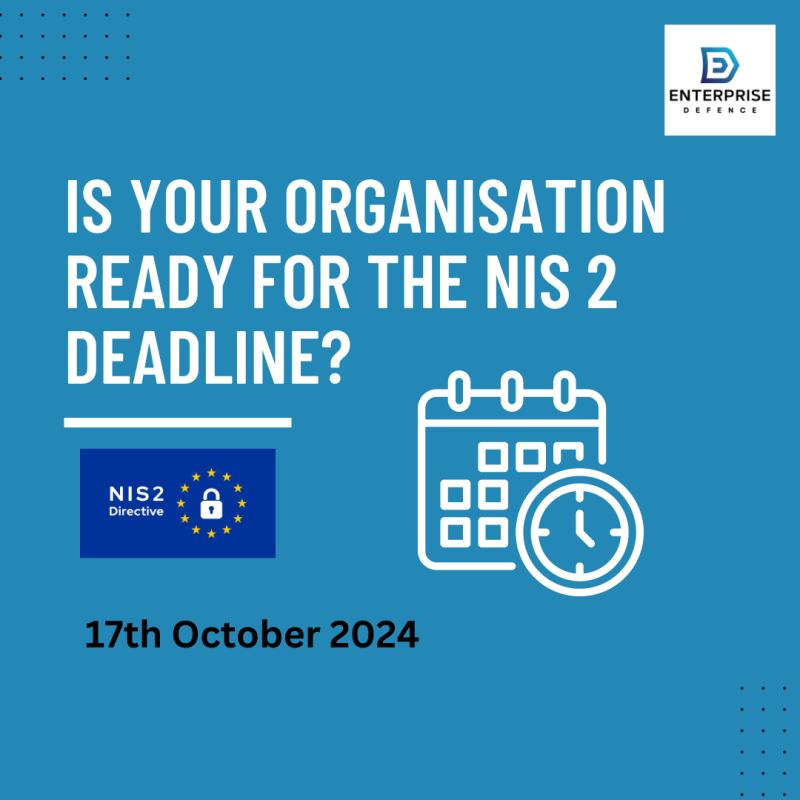
NIS 2 Compliance: CEO’s Guide Before Oct 17th Deadline 2024
Navigating NIS 2: CEO’s Essential Roadmap to Compliance Before the October 17th, 2024 Deadline
With the deadline for NIS 2 compliance looming on October 17th, 2024, CEOs and management are at the forefront of ensuring their organisations are adequately prepared to meet regulatory requirements. As the clock ticks down, understanding what NIS 2 entails and taking decisive action is paramount for safeguarding operations, reputation, and compliance. In this blog, we’ll explore what CEOs and management need to know and do before the approaching deadline.
Under NIS2, financial penalties may be up to either €10,000,000 or 2% of the global yearly revenue, whichever is the greater amount.
The Countdown to Compliance:
NIS 2 represents a significant evolution in cybersecurity regulation, demanding stricter obligations and heightened measures to protect critical infrastructure and digital services. For CEOs and management, proactive preparation is essential to navigate this regulatory landscape effectively. With less time than you might think, here’s what you need to know and do to achieve compliance before October 17th, 2024.

How to Achieve NIS 2 Compliance:
Understanding the Stakes:
Compliance with NIS 2 isn’t just about avoiding penalties—it’s about safeguarding the future of your organisation. Non-compliance can lead to severe consequences, including hefty fines, legal liabilities, and reputational damage. By prioritising NIS 2 readiness, CEOs and management demonstrate a commitment to cybersecurity resilience and regulatory compliance, bolstering trust and confidence among stakeholders.
Assessing Current Readiness:
Begin by conducting a comprehensive assessment of your organisation’s cybersecurity posture. Evaluate existing controls, identify vulnerabilities, and gauge compliance with NIS 2 requirements. This assessment provides valuable insights into areas that require attention and serves as a baseline for developing a tailored compliance strategy.
Developing a Strategic Plan:
With the deadline fast approaching, it’s crucial to develop a strategic roadmap for NIS 2 compliance. Define clear objectives, allocate resources, and establish accountability within the organisation. Break down the compliance process into actionable steps, setting milestones and deadlines to track progress effectively.
Implementing Necessary Measures:
Take decisive action to implement the necessary security measures and controls outlined in NIS 2. This may include deploying technical solutions, enhancing incident response capabilities, and strengthening access controls. Collaborate with cybersecurity experts like Enterprise Defence to ensure alignment with regulatory requirements and industry best practices.
Training and Awareness:
Invest in training and awareness initiatives to educate employees about cybersecurity risks and best practices. Empower staff to recognise potential threats, report incidents promptly, and adhere to security protocols. Foster a culture of cybersecurity awareness, where every employee understands their role in maintaining a secure environment.
Regular Monitoring and Review:
Establish mechanisms for ongoing monitoring and review of cybersecurity controls and compliance efforts. Conduct regular audits, assessments, and simulations to identify gaps and areas for improvement. Stay vigilant to emerging threats and regulatory updates, adapting your approach as needed to remain compliant.
Seeking External Support:
Don’t hesitate to seek external support from cybersecurity experts and consultants like Enterprise Defence. Leverage our expertise to streamline the compliance process, address complex challenges, and accelerate progress towards NIS 2 readiness. By partnering with trusted advisors, CEOs and management can navigate the complexities of compliance with confidence.
As the deadline for NIS 2 compliance draws nearer, CEOs and management must act decisively to ensure their organisations are prepared. By understanding the stakes, assessing current readiness, developing a strategic plan, implementing necessary measures, investing in training and awareness, monitoring progress, and seeking external support, organisations can navigate the road to compliance successfully. With proactive action and strategic foresight, CEOs and management can safeguard their organisations against cyber threats and demonstrate a commitment to cybersecurity resilience in an increasingly digital world


